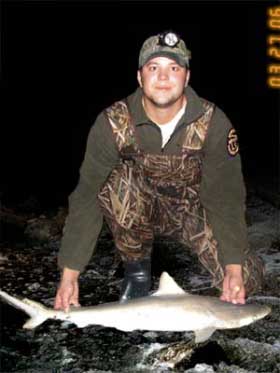 |
| Nokomis-area student Laura Zimmerley holds
one of the shark teeth that brought the unlikely search
to Minnehaha Creek. State DNR and Park Board officials watch
as DNR biologists drive fish downstream towards waiting
nets She was invited to watch as they began their search
in the pool below Minnehaha Falls on Sunday, March 26. Photo
by fdw/NENA. |
 |
| Minnesota DNR biologist Dan Marais holds
the larger of two juvenile Bull Sharks netted near the mouth
of Minnehaha Creek during the early hours of March 27. Photo
courtesy of Mn Department of Fisheries and Wildlife. |
 |
| On February 12, 2006, divers working with
Wisconsin DNR Fisheries personnel, caught this five-foot
female Bull Shark under the ice on Lake Pepin, part of the
Mississippi River. The nearly dormant shark was tagged with
a radio tracking device and released. Photo courtesy of
the Wisconsin Bureau of Fisheries Management and Habitat
Protection. |
Minneapolis, MN -- Shortly after Jaws opened in
Minneapolis theatres back in the summer of 1975, the number of
swimmers using our area lakes and pools plunged significantly.
So, when a 10 year-old Minneapolis student approached Minnesota
DNR biologist Dan Marais about three fossilized shark’s teeth
she had found in Minnehaha Creek, he could only smile to himself.
More shark tales, he thought. That is, until he actually saw the
teeth.
They did, in fact, come from sharks. However,
two of the specimens were clearly not fossils, but teeth shed
from a contemporary shark. Curious about the origins, Marais
called a colleague at the Department of Fisheries and Wildlife
to help identify the teeth and perhaps avoid falling victim
to a hoax. What he learned made the small hairs on the back
of his neck stand up.
After Hurricanes Katrina and Rita last year,
a report by Gulf marine scientists had warned that the enormous
amount of pollution back-flushed into the Gulf of Mexico would
cause many species of marine animals to either relocate or perish.
That expected decimation of the food chain led to warnings of
a possible migration of coastal sharks into rivers where a higher
oxygen content would support more aquatic life. Specifically,
they were watching for the common Bull Shark (Carcharhinus leucas).
The stuff of legends, this aggressive shark was already known
for its ability to live, feed, and even breed in extremely shallow
fresh waters. Bull Sharks had previously been documented as
far north as the Ohio River. They have also been attributed
to most of the attacks on humans worldwide.
Lab technicians positively identified these
two teeth as having come from a two-to-three year-old Bull Shark.
However, it was a semi-classified document dated February 12,
2006 from the Wisconsin DNR that really set the wheels in motion.
On that date, ice-diving biologists captured a nearly comatose
five-foot Bull Shark in Lake Pepin, a widening of the Mississippi
River. They were responding to reports from several startled
salvage divers of a sleeping, “shark-like fish” in
the open cab of a pickup truck that had gone through the ice
a few weeks earlier. The Wisconsin divers located the truck
in approximately 18' of water with the shark still inside, apparently
hiding from the swift current. But the cold water had slowed
its respiration and metabolism so much that it was barely alive.
After an examination, the fish was tagged with a radio location
device and released back into the river (Wisconsin regulations
do not allow the keeping or transport of live, non-game fish).
Sadly, marine biologists doubt the fish will survive until summer
without the needed quantity of minerals and trace elements found
in saltwater.
Worried about the negative effect on local recreation
a man-eating shark might possibly cause, Minnesota officials
ordered an immediate sweep of Minnehaha Creek. On Saturday,
March 26, conservation officers began their search below the
falls using ultrasonic stun devices to drive any fish downstream
and into gill nets strung across the mouth of the creek. Despite
catcalls and hoots from park patrons, the team worked downstream
throughout the day and into the night. It was difficult work
with shallow water and an unusual number of recently downed
trees blocking the creek.
A little after midnight, two juvenile sharks
were captured along with dozens of rough fish and several spawning
Northern Pike. Both sharks were malnourished and docile, but
in overall better health than the larger Lake Pepin specimen.
The two fish are now in a special hospital tank at the Minnesota
Zoo in Apple Valley, undergoing observation and a slow acclimatization
back to salt water. The staff there have named them Lenny and
Frankie, after two of the characters from the 2004 animated
feature, Shark Tale.
This summer, scientists plan to install experimental
freshwater sonar devices to watch for sharks in the two-mile
stretch of the Mississippi between the Ford Dam and its confluence
with the Minnesota River at Fort Snelling State Park.
For the safety of its visitors, the Minneapolis
Park and Recreation Board ordered signs prohibiting cliff diving
or swimming in or below Minnehaha Falls until further notice.
So what about those two teeth? Technicians dated
them by comparing tannin stain penetration to known levels in
the Creek. They judge that the teeth had been in the creek for
7-10 years. Long before Hurricane Katrina.
Laura Zimmerley, feeling vindicated nowadays,
can be heard humming the theme song from Jaws... Dah duh, dah
duh, dah duh… |